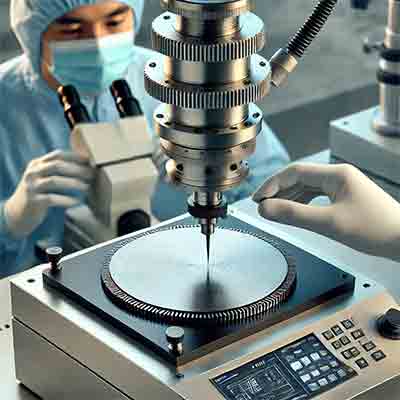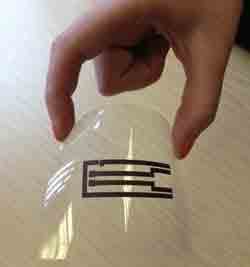We are looking for silicon wafers that would be suitable for
fabrication of optical silica waveguides. I think SSP prime wafers 4" with
very low surface roughness would be best <1nm or better as a starting bare wafer. I don't know what coin roll grade is but I suspect it is a lower
grade. Could you quote having 10um and 15um of thermal oxide?
Surface Roughness of Various Substrates
Thick Thermal Oxide Silicon Wafers With Low Surface Roughness Optical Silica Waveguides
A Distinguished Professor researching Silicon photonics, optical communications, fiber optic networks, photonic integrated circuits, quantum photonics requested the follwoing quote:
Reference #111453 for specs and pricing.
Get Your Silicon Wafer Quote FAST! Or, Buy Online and Start Researching Today!
SOI Wafers With Low Surface Roughness
We would like to procure SOI Wafer for our cleanroom. Please find attached the specifications and the quantity required by us.
Common specifications to all wafer types are as follows:
- All wafers are double side polished with Primary flat, surface
roughness within 1 to 2 nm. - <100> orientation of device as well as carrier wafers.
- Carrier wafer thickness = 400±10 microns
- All wafers – 4 inch diameter
Reference #176466 for specs and pricing.
Surface Roughness To Be Analysed By AFM
An assistant professor researching Ev power requested the following quote:
For the below mentioned specifications of SiC wafers, please do provide us your quotation.
Specification of SiC wafers:
Polytype: 6H SiC
Dia: 50 mm
Type/Dopant: N type - Nitrogen doped
Orientation: 3.5+0.5 towards <112bar0>
Thickness: 330+25 u
Micropipe density: Less than 50 arcsec
Surface finish: Both faces polished with C face epi-ready
Surgace roughness: Less than 0.5nm
Packaging: Single wafer container
Acceptance criteria for SiC wafers
Various property parameters of the supplied wafers will be verified to ensure that they are within the limits specified in the technical specifications. The following experimental analysis will be carried out.
- Chemical composition to be verified by XRD
- Polytype and face identification to be confirmed by Raman Spectrocopy
- Thickness to be verified by SEM microsturcture analysis
- Surface roughness to be analysed by AFM.
- Micropipe density and FWHM value
Reference #202899 for specs and pricing.
Glass Surface Roughness for Oxide Semiconductors
A PhD candidate requested a quote for the following:
Our lab is interested in purchasing some 3-inch and 6-inch Glass wafers, possibly around 100 pieces each.
We found many glass wafers on your website, but we have some difficulties in making a decision. More information will be needed for us to determine whether the wafer is suitable for our experiments.
I wonder if it is possible for you to provide us with some data on the surface roughness and electrical resistivity of your glass wafers (Only those ones are available in 3-inch and 6-inch size).
Reference #209421 for specs and pricing.
Why Is The Surface Roughness Of A Silicon Wafer Important?
The surface roughness of a silicon wafer is crucial for several reasons, particularly in the semiconductor manufacturing process. Here's a detailed explanation:
1. Device Performance and Reliability
- Electrical Properties: The surface roughness of a silicon wafer can significantly affect the electrical
 properties of the semiconductor devices. A smoother surface allows for better formation of thin films and more reliable doping profiles, which are essential for the optimal performance of electronic components.
properties of the semiconductor devices. A smoother surface allows for better formation of thin films and more reliable doping profiles, which are essential for the optimal performance of electronic components. - Leakage Currents: Increased surface roughness can lead to higher leakage currents in devices, reducing their efficiency and reliability. This is particularly important for components like transistors, where minimizing leakage is critical.
2. Photolithography and Pattern Transfer
- Precision in Photolithography: The photolithography process, which involves transferring patterns onto the silicon wafer, requires extremely smooth surfaces for accurate pattern transfer. Surface irregularities can cause distortions and defects in the patterns, leading to faulty devices.
- Resolution: High surface roughness can limit the resolution of the patterns that can be achieved, affecting the overall miniaturization and complexity of the semiconductor devices.
3. Thin Film Deposition
- Uniformity: When depositing thin films (such as oxides, nitrides, or metals) onto the wafer, a smooth surface ensures uniform thickness and properties of the films. Variations in surface roughness can lead to non-uniform deposition, resulting in poor film quality and device performance.
- Adhesion: Smooth surfaces improve the adhesion of thin films, which is vital for the mechanical stability and longevity of the devices.
4. Chemical-Mechanical Planarization (CMP)
- Planarization Efficiency: CMP is a process used to smooth and flatten the wafer surface. If the initial surface roughness is too high, CMP may not achieve the desired level of flatness, impacting subsequent manufacturing steps.
- Defect Minimization: A smoother initial surface reduces the likelihood of introducing defects during the CMP process, which is crucial for maintaining the integrity of the wafer.
5. Yield and Cost
- Defect Reduction: Surface roughness directly correlates with the number of defects that can occur during the manufacturing process. Smoother wafers typically result in fewer defects, improving the overall yield of usable devices from each wafer.
- Manufacturing Costs: Higher yields translate to lower manufacturing costs per device, making the production process more economical and efficient.
Conclusion
The importance of surface roughness in silicon wafers cannot be overstated, as it impacts nearly every aspect of semiconductor manufacturing, from device performance and reliability to production yield and cost. Ensuring minimal surface roughness is a key factor in producing high-quality, high-performance semiconductor devices.
PET Sheet Surface Roughness
A postdoc requested a quote for the following:
We are looking for Polyethylene terephthalate (PET) thin sheets to be used as substrates for film deposition pupose. We are looking for transparent PET without any pattern. The surface roughness should not be large. Any thickness will work as long as PET is transparent.
pupose. We are looking for transparent PET without any pattern. The surface roughness should not be large. Any thickness will work as long as PET is transparent.
Reference #211070 for specs and pricing.
YAG Substrates With Low Surface Roughness
A senior development engineer requested a quote for the folllowing:
We are looking for 17mm diameter YAG disks (anything close to this diameter would be OK) with a prime grade surface polish (SSP or DSP). Ideally the surface roughness would be rms < 1nm.
These are to be mechanical substrates so the laser/electrical/dopant properties of the disks does not matter to us. Whatever is least expensive is the best option for our purposes.
Reference #221322 for specs and pricing.
